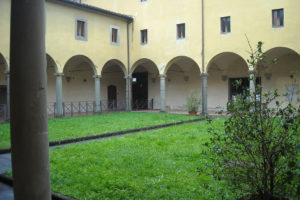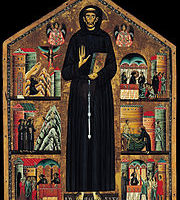Panoramica
L’importanza del convento e della Chiesa di San Francesco a Pescia derivano dal fatto che il santo in persona ha visitato questi luoghi ed ha voluto che fosse edificato quello che è arrivato fino a noi, e cioè un luogo spirituale e di carità. La chiesa e il convento risalgono al XIII secolo e l’opera d’arte più preziosa e significativa è quella che risulta la prima del suo genere e cioè una tavola con iconografie delle storie francescane del 1235 intitolata “San Francesco e le storie della sua vita” dipinta da Bonaventura Berlinghieri.
Secondo la testimonianza di L. Wadding, Annales Minorum, la tradizione vuole che san Francesco prima di proseguire alla volta di Pisa, ove ebbe come discepoli il Beato Agnello degli Agnelli e il Beato Alberto, si fermò per tre giorni a Pescia, gradito ospite del ricco e pio mercante Venanzio degli Orlandi, il quale gli fece dono di un piccolo oratorio e di una casupola, perché vi stabilisse un convento per i suoi frati.
“Folgorato dalla Grazia divina, dopo aver cambiato la cintura e gli speroni dell’elegante cavaliere con la corda e i sandali dell’eremita, attraversata la fiorente Valdinievole, ai primi di ottobre del 1211, giunse a Pescia Francesco d’Assisi, umile servo e seguace di Cristo, per attuare qui, come altrove, la pacifica silenziosa rivoluzione, nell’audace intento di riportare il costume cristiano alla purità delle origini”. ( L. Wadding, Annales Minorum).
Il Santo, preceduto dalla fama di pacificatore, giunse a Pescia, travagliata, come altre città, da discordie tra comuni, dalla violenza e da contrasti interni ed esterni e, accogliendo il dono del conte Venanzio degli Orlandi, fece venire due frati da Firenze affinché si prendessero cura dell’oratorio al quale, probabilmente, era annesso un ospizio. La chiesetta “disgiunta dalla terra ferma quanta è la lunghezza di un ponte sul fiume Pescia, che da essa la divide” era situata nella parte settentrionale della città, in luogo detto “Giocatoio”. La realizzazione del “ponte san Francesco” come venne chiamato e demolito dopo la seconda guerra mondiale, si rese necessaria perché sull’altra sponda il piccolo insediamento francescano diventava sempre più polo di attrazione spirituale e caritativo. L’oratorio di cui parliamo, oggi, fa parte dell’attuale chiesa ed era situato tra la cappella della Concezione e quella della “Corda Pia” o Cappella Cardini. Il piccolo oratorio venne quasi subito ampliato dallo stesso Venanzio Orlandi quando Gregorio IX innalza san Francesco al la gloria degli altari. Molte famiglie pesciatine come gli Albizi, i Mainardi, i Della Torre concorsero ad abbellire quello che anche oggi è il più celebre monumento artistico della città.
Fra le note di spicco ci sono le varie cappelle che adornano il transetto centrale e sono: cappella Orlandi-Cardini; cappella Maggiore; cappella del SS.Sacramento; cappella dell’Immacolata Concezione; cappella Nucci; cappella sant’Anna.
Se vai al seguente link trovi uno stupendo video interattivo a 360° della Chiesa con guida descrittiva delle opere https://www.thinglink.com/video/1079712249133662209
Al seguente link il sito ufficiale di riferimento dell’Ordine francescana per la Provincia Italiana: https://provinciaitalianasanfrancesco.it/conventi-toscana/convento-san-francesco-pescia/
e da Wikipedia: https://it.wikipedia.org/wiki/Chiesa_di_San_Francesco_(Pescia)
« Altissimu, onnipotente, bon Signore, tue so’ le laude, la gloria e ‘honore et onne benedictione.
Ad te solo, Altissimo, se konfàno et nullu homo ène dignu te mentovare.
Laudato sie, mi’ Signore, cum tucte le tue creature, spetialmente messor lo frate sole, lo qual è iorno, et allumini noi per lui. Et ellu è bellu e radiante cum grande splendore,de te, Altissimo, porta significatione.
Laudato si’, mi’ Signore, per sora luna e le stelle, in celu l’ài formate clarite et pretiose et belle.
Laudato si’, mi’ Signore, per frate vento et per aere et nubilo et sereno et onne tempo, per lo quale a le tue creature dài sustentamento.
Laudato si’, mi’ Signore, per sor’aqua, la quale è multo utile et humile et pretiosa et casta.
Laudato si’, mi’ Signore, per frate focu, per lo quale ennallumini la nocte, et ello è bello et iocundo et robustoso et forte.
Laudato si’, mi’ Signore, per sora nostra matre terra, la quale ne sustenta et governa, et produce diversi fructi con coloriti flori et herba.
Laudato si’, mi’ Signore, per quelli ke perdonano per lo tuo amore, et sostengo infirmitate et tribulatione.
Beati quelli che ‘l sosterrano in pace, ca da te, Altissimo, sirano incoronati.
Laudato si’ mi’ Signore per sora nostra morte corporale, da la quale nullu homo vivente pò scappare: guai a quelli che morrano ne le peccata mortali;
beati quelli che trovarà ne le tue santissime voluntati, ka la morte secunda no ‘l farrà male.
Laudate et benedicete mi’ Signore’ et ringratiate et serviateli cum grande humilitate » San Francesco, Cantico delle Creature.
English version below
The importance of the convent and of the Church of San Francesco a Pescia derive from the fact that the saint himself visited these places and wanted to build what has come down to us, namely a spiritual and charitable place. The church and the convent date back to the 13th century and the most precious and significant work of art is the one that is the first of its kind, namely a panel with iconographies of the Franciscan stories of 1235 entitled “Saint Francis and the stories of his life “painted by Bonaventura Berlinghieri.
According to the testimony of L. Wadding, Annales Minorum, tradition has it that St. Francis before going on to Pisa, where he had as his disciples the Blessed Agnello degli Agnelli and the Blessed Alberto, stayed for three days in Pescia, welcome guest of rich and pious merchant Venanzio degli Orlandi, who gave him the gift of a small oratory and a small house, to establish a convent for his friars.
“Lightened by the divine grace, after having changed the belt and the spurs of the elegant knight with the rope and sandals of the hermit, crossed the thriving Valdinievole, in early October 1211, he arrived in Pescia Francesco d’Assisi, humble servant and follower of Christ, to implement here, as elsewhere, the peaceful silent revolution, in the audacious intent to bring the Christian custom back to the purity of the origins. “(L. Wadding, Annales Minorum).
The Saint, preceded by his reputation as a peacemaker, arrived in Pescia, troubled, like other cities, by discords between municipalities, by violence and internal and external contrasts and, welcoming the gift of Count Venanzio degli Orlandi, had two friars come from Florence to took care of the oratory to which, probably, a hospice was annexed. The church “separated from the mainland as the length of a bridge over the river Pescia, which divides it from it” was located in the northern part of the city, in a place called “Giocatoio”. The realization of the “ponte san Francesco” as it was called and demolished after the second world war, became necessary because on the other shore the small Franciscan settlement became more and more a pole of spiritual and charitable attraction. The oratory we are talking about today is part of the current church and was located between the Chapel of the Conception and that of the “Corda Pia” or Cappella Cardini. The small oratory was almost immediately enlarged by Venantius Orlandi himself when Gregory IX raised Saint Francis to the glory of the altars. Many families such as the Albizi, the Mainardi, Della Torre concorsero to embellish what is still today the most famous artistic monument of the city.
Among the prominent notes are the various chapels that adorn the central transept and are: Orlandi-Cardini chapel; Major Chapel; chapel of the Holy Sacrament; chapel of the Immaculate Conception; Nucci chapel; St. Anne chapel.
If you go to the following link you will find a wonderful 360 ° interactive video of the Church with a descriptive guide to the works https://www.thinglink.com/video/1079712249133662209
At the following link the official reference site of the Franciscan Order for the Italian Province: https://provinciaitalianasanfrancesco.it/conventi-toscana/convento-san-francesco-pescia/
and from Wikipedia: https://it.wikipedia.org/wiki/Chiesa_di_San_Francesco_(Pescia)
“Most High, Almighty Good Lord, your praise, glory, honor and blessing are yours.
To you alone, Most High, befitting and no man is worthy to mention you.
Praise be, my Lord, together with all creatures, especially the sun-brother, who is the light of day, and you through him enlighten us. And he is beautiful and radiant with great splendor: his importance is very important.
Praised be or my Lord, for sister moon and the stars: in heaven you have formed them, clear precious and beautiful.
Praised be, my Lord, by brother wind, and by air and by heaven; the cloudy one and the serene one, each time by which the creatures from sustenance.
Praised be my Lord, for sister water, which is very useful and humble, precious and pure.
Praised be my Lord, through brother fire, through which I lighten the night. It’s beautiful, jolly, robust and strong.
Praised be my Lord, for our sister mother earth, who gives us nourishment and keeps us: he produces different colored fruits, with flowers and grass.
Praised be my Lord, for those who forgive in the name of your love, and endure sickness and suffering.
Blessed are those who will endure this serenely, because they will be rewarded.
Praised be my Lord for our bodily death, from which no human being can escape, woe to those who will die while in a situation of mortal sin.
Blessed are those who will find it while they are respecting your wishes. The second death will do them no harm.
Praise and bless my Lord, thank him and serve him with great humility. » San Francis, Canticle of the creatures.
Mappa
visto 4207 tempi, 1 Visita oggi








